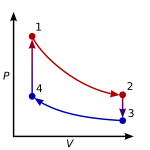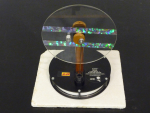UW Physics
Lecture Demos
Policies & GuidelinesDemonstrationsFull CatalogCourse Demo ListsEquipment Details & ManualsLinks
|
4 - Thermodynamics
| Thermal Properties Of Matter | | Heat And The First Law | | Change Of State | | Kinetic Theory | | Gas Law |
4A - Thermal Properties Of Matter4A10 - Thermometry
| Liquid Crystal Sheets (4A10.50)
Large sheets of temperature sensitive liquid crystals change color with temperature. |
4A20 - Liquid Expansion_th.jpg) | Thermal Expansion of Water (4A20.10)
A flask filled with colored water has a long glass tube protruding up from the neck. A gas flame is placed under the flask and thermal expansion forces water up the tube. |
| Negative Expansion Coefficient of Water (4A20.30)
A flask of colored water with a glass tube inserted through the stopper is kept in a bath of ice water until the temperature of the water in the flask has fallen to 0 C. The water level in the vertical tube is noted, and the flask and tube are removed from the ice bath. As the temperature of the flask water rises, the water level in the tube drops until the water has warmed to about 4 C, the temperature of maximum density, then begins to rise. Demonstrates why ice floats, and always forms at the top surface of the water. Note: Needs to be rebuilt with a smaller flask. |
| Density of 4 C Water (4A20.35)
A mixture of ice and water in a beaker is placed on a styrofoam pad. After coming to equilibrium, a large thermometer can be used to show that the water up around the ice is at 0 C, while the denser water at the bottom is at 4 C. |
4A30 - Solid Expansion_th.jpg) | Bimetallic Strip (4A30.10)
Two different metal strips bonded together and fastened to a handle. When heated, the strip bends because of the different expansion rates of the metals. |
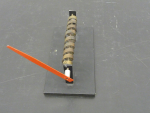 | Bimetallic Coil
Same as the bimetallic strip, but helical in form. The coil is heated and moves a large indicator arrow as it expands. |
| Thermostat Model (4A30.11)
A model of a thermostat with a lamp heater and a bimetallic strip. |
_th.jpg) | Ball and Ring (4A30.21)
A metal ball and ring on handles are constructed so that the ball will just pass through the ring at room temperature. The ball is heated and will not pass through the ring. The ball and ring are both heated and the ball now passes through the heated ring. |
_th.jpg) | Ball and Hole (4A30.22)
A ball which is too large to pass through a hole in a square metal plate will pass easily through the hole after the plate has been heated in a flame. Many students expect the hole to shrink upon heating, but it actually expands along with the rest of the plate. |
| Heated Wire (4A30.60)
A thin wire supported at both ends is electrically heated and the wire sags in the middle. |
4A40 - Properties of Materials at Low Temperatures | Elasticity at Low Temperatures (4A40.15)
A lead spring is dipped in liquid nitrogen and hooked on a vertical stand. A weight is attached to the end of the spring and set into oscillation. The spring will oscillate when cold, but as it warms up its elastic limit is lowered and the weight sags onto the table. |
| Smash Stuff in Liquid Nitrogen (4A40.30)
Cool flowers, racquetballs, fruit, etc. in liquid nitrogen. Please bring your own items (no watermelons). |
4B - Heat And The First Law4B10 - Heat Capacity and Specific Heat | Calorimeter (4B10.26)
A double walled aluminum calorimeter with hole on top for a thermometer; used for heat of fusion of water, etc. |
| Specific Heat with Metal Shot (4B10.28)
Three equal masses of metal shot (aluminum, steel, and lead) are heated in boiling water, dumped into equal masses of room temperature water and stirred. The final temperature of each is read with a large display thermometer. Reasonable figures for the heat capacities of the metals can be obtained from the data. |
| Specific Heat with Rods and Wax (4B10.30)
Cylinders of lead, brass, and aluminum are heated in boiling water, then lifted onto a block of paraffin. The weights melt through the wax with speeds approximately proportional to their heat capacities. |
_th.jpg) | Ruchardt's Experiment for gamma (Cp/Cv) (4B10.70)
A steel ball in a precision tube oscillates as gas escapes from a slightly overpressured flask. By measuring the oscillation frequency, you can determine the ratio gamma = Cp/Cv. Note: Please talk to us in advance. |
4B20 - Convection_th.jpg) | Convection in Square Tube (4B20.10)
A large glass square loop is filled with water and heated by a burner near one bottom corner. The resulting circulating convection current is shown by adding drops of dye to the water. |
4B30 - Conduction_th.jpg) | Thermal Conductivity (4B30.12)
Five rods of different composition are attached to a steam chamber to provide equal temperatures at the bases of the rods. The rods are covered with wax, which melts and peels off as the rods heat up. Relative rates of heat conduction can be deduced from the rates at which the wax melts on each rod. The five materials in order of decreasing conductivity are: copper, aluminum, brass, steel, and glass. |
4B40 - Radiation | Leslie Cube (Video) (4B40.30)
Status: Unavailable
A brass cube filled with hot water has four different faces: plain brass, painted white, painted glossy black, and one painted flat black. A thermocouple connected to a projection galvanometer is positioned near the Leslie cube and the cube is rotated on its base so that each face passes in front of the thermocouple. A different rate of radiation is seen from each face. |
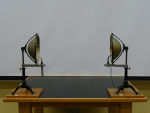 | Radiation from Hot and Cold Bodies
Two parabolic reflectors are aligned facing each other, with a thermopile at the focal point of one of the reflectors and a heated sphere at the other. A projection galvanometer's deflection shows the transmission of heat by radiation. Replace the hot sphere with a sphere dipped in liquid nitrogen and the galvanometer will deflect in the opposite direction (showing that the thermopile itself is radiating and heat flows to the cold sphere). |
4B50 - Heat Transfer Applications_(4B50.10)_th.jpg) | Insulation (Dewar Flasks) (4B50.10)
Four dewar flasks (thermos bottles) are filled with boiling water and a thermocouple is placed in each. Each flask has a different degree of insulation, and these are (from worst to best): unsilvered without vacuum between the walls, silvered without vacuum, unsilvered with vacuum, and silvered with vacuum. The water temperature is measured throughout the class period and compared to an uninsulated beaker. Temperatures are collected and displayed via a LabVIEW program and a laptop plugged into the projector. |
| Water Balloon Heat Capacity (4B50.25)
A lit match may be held directly beneath a water balloon without burning through the balloon, due to the high heat capacity of the water. In contrast, an air balloon explodes immediately on contact with the flame. |
| Leidenfrost Effect (4B50.30)
Pour water onto a very hot pan, or pour liquid nitrogen on the floor. |
4B60 - Mechanical Equivalent of Heat_th.jpg) | Drill and Dowel (4B60.55)
A wooden dowel held in an electric drill chuck is ground against a large flat piece of wood. The friction between the two produces heat and smoke. |
_th.jpg) | Cork Popper (4B60.70)
A motorized rotating hollow shaft holds a thimblefull of water and is sealed with a stopper. Wood brakes are squeezed together on either side of the rotating shaft, and the heat generated by friction boils the water and pops the cork. |
4B70 - Adiabatic Processes | Fire Syringe (4B70.11)
Compress air to ignite two match heads. |
| Temperature Change with Compression (4B70.31)
A plastic syringe contains a thermocouple in the tip that connects to a large display thermometer. If the syringe is compressed rapidly, a temperature rise is seen on the thermometer. Pulling the plunger out rapidly lowers the temperature of the air inside. |
| CO2 Cartridge Adiabatic Cooling (Joule-Thomson) (4B70.40)
A sealed CO2 cartridge at room temperature is punctured and the gas expands and cools. A thermocouple measures the temperature drop of the cylinder. |
4C - Change Of State4C10 - PVT Surfaces
4C20 - Phase Changes: Liquid - Solid | Regelation (4C20.30)
A block of ice is supported at ends and a thin wire with weights attached is hung over the top. Pressure from the wire decreases the melting temperature of the ice, and the wire will pass through the block without cutting it in two (the ice refreezes behind the wire) within 15 to 30 minutes. |
| Heat of Crystallization (4C20.60)
A commercial hand warmer for campers. Contains a solution of sodium acetate that crystalizes and releases heat |
 | Thermite
An extremely exothermic reaction between Iron Oxide (rust) and Aluminum produces liquid Iron. |
4C30 - Phase Changes: Liquid - Gas | Boil Water Under Reduced Pressure (4C30.10)
A special flask with a concave depression in its bottom is filled with water and boiled to drive out the air. The flask is then sealed with a stopper and thermometer (which shows the water is boiling at 100 C), turned upside down, and cooled by filling the hollow with ice. The resulting pressure reduction causes the water to boil at a reduced temperature (70 to 80 C or even lower). |
| Liquid Nitrogen in a Balloon (4C30.35)
A small amount of liquid nitrogen is poured into a balloon and allowed to evaporate and expand. |
| Note: Electrolysis of Water (5E20.10) is listed in Section 5E20 - Electrolysis.
|
4C31 - Cooling by Evaporation | Cryophorus (4C31.10)
A partially evacuated glass tube that contains some water in the bulb on one end. The other empty end is placed in liquid nitrogen and the change in pressure causes the water to boil and then freeze. |
| Freezing Water by Evaporation (Triple Point) (4C31.20)
Air pressure is lowered almost to vacuum over a small sample of water, which begins to boil. Evaporation in vacuum lowers the temperature of the water until it reaches the triple point at .01 C where it then freezes. |
_th.jpg) | Drinking Bird (4C31.30)
Commercial novelty item. Dip the bird's beak into a beaker of water, then let it go. Evaporation of the water from the wet beak cools the beak, lowering the vapor pressure of the liquid inside and drawing it up into the head. That overbalances the bird and it tips into the water for a "drink." In that position, the liquid inside flows back into the lower bulb, which rights the bird and starts the cycle over. Note: This is not very visable for a large class without using a camera. |
4C33 - Vapor Pressure_th.jpg) | Hand Boiler (Franklin's Pulse Glass) (4C33.50)
A glass tube contains a small amount of a volatile liquid (Methylene Chloride). Heat from your hand will boil the liquid and the vapor pressure will force it to flow to the opposite end of the tube. Note: This is small and not very viewable for a large class. |
4C40 - Sublimation | Sublimation of CO2 (4C40.10)
CO2 is solidified by dipping a balloonful in a container of liquid nitrogen. The balloon is cut open to show the solid CO2, which sublimates directly to the gaseous state. |
4C50 - Critical Point_th.jpg) | Critical Point of CO2 (4C50.10)
liquid CO2 in a glass tube at high pressure is close enough to the critical point that warm air from a hair dryer will complete the transition. The tube is displayed with a video camera and the meniscus is seen, but when the tube is heated the meniscus slowly fades and disappears as the liquid CO2 goes through a gradual transition to a high pressure gas. A turbulent mixture of liquid and gas with equal densities is seen above and below the miniscus point. |
_th.jpg) | Critical Opalescence (4C50.20)
A mixture of triethylamine and water is heated and passes through the liquid/gas critical point. The liquid is clear at first, then becomes cloudy as it approaches the critical point. |
4D - Kinetic Theory4D10 - Brownian Motion | Brownian Motion in Smoke (4D10.10)
A chamber is filled with smoke and observed with a camera. See also Molecular Motion Demonstrator (4D30.20). |
4D20 - Mean Free Path_th.jpg) | Crooke’s Radiometer (4D20.10)
A partially evacuated glass bulb holds a pinwheel where the vanes are reflective on one side and painted black on the other. Light from an incandescent lamp will be absorbed by the dark side of the vanes, heating the nearby air, and causing the pinwheel to rotate towards the reflective side of the vanes. |
4D30 - Kinetic Motion | Molecular Motion Demonstrator (4D30.20)
A small variable speed motor shakes a metal frame mounted over a glass plate. Various sized plastic and metal balls placed in the frame bounce randomly about, simulating molecular motion. Concepts which may be demonstrated include temperature, equipartition, diffusion, and Brownian motion. |
4D50 - Diffusion and Osmosis_th.jpg) | Bromine Diffusion (4D50.45)
Two glass tubes containing bromine and bromine/air are cooled in liquid nitrogen and allowed to warm back up to show rates of diffusion. The bromine only tube will diffuse faster than the bromine/air mixture. |
4E - Gas Law4E10 - Constant Pressure
| Helium Balloon in Liquid Nitrogen (4E10.22)
Charles's Law or Volume vs. Temperature. A helium balloon is drenched with liquid nitrogen. As the helium shrinks in volume, the balloon loses buoyancy and comes to rest on the table. As the helium warms up, the balloon expands and begins to float again. Note: Constant pressure here is atmospheric pressure. |
4E20 - Constant Temperature
4E30 - Constant Volume | Gay-Lussac's Law (Pressure vs. Temperature) (4E30.10)
A hollow metal sphere is attached via tubing to a pressure gauge on the overhead projector. The sphere is immersed in water baths of various temperatures (boiling, room temperature, and ice water) and the corresponding pressure is noted. |
| Constant Volume Gas (Pressure Thermometer) (4E30.20)
Status: Unavailable
Constant volume is maintained by adjusting a water column, and pressure is read from the height of water in the other leg of the tube. Qualitative only, and only usable for small changes in pressure. |
4F - Entropy And The Second Law4F10 - Entropy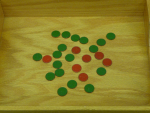 | Entropy Pennies
A tray is filled with pennies painted green on the tails and red on the heads. If the tray is shaken the pennies begin to flip at a rate dependent on the magnitude of the shaking. Eventually an equilibrium is reached, with approximately equal numbers of reds and greens. Further shaking will not, of course, return them to their original state. If only a few pennies are used, they will occasionally return to their original state, showing the dependence upon the number of particles in the system. |
_th.jpg) | Mixing and Unmixing (4F10.10)
The volume between two coaxial cylinders is filled with glycerin and a thin column of red dye. When the inner cylinder is rotated, the dye appears to be mixed but is distributed in a fine cylindrical shell within the glycerin. Reversing the direction of inner cylinder rotation will cause the original dye column to reappear. Note: Please talk to us about this first. |
4F30 - Heat Cycles_th.jpg) | Heron's Engine (or Hero's Engine) (4F30.01)
A working model of the first primitive steam engine. A glass globe containing a small amount of water is heated with a flame. The steam produced comes out through two arms and spins the globe. |
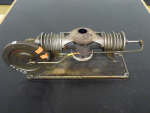 | Stirling Engine - Heavy Duty
A heavy duty Stirling engine. This is the biggest engine, but perhaps the least instructive because of low visibility. |
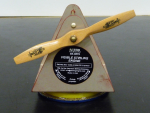 | Stirling Engine - Hot and Cold
Will run in one direction when placed on a hot resevoir, and will run in reverse when placed on a cold resevoir. Note: May be out of service. |
| Cutaway Steam Engine (4F30.31)
A cutaway model of a steam engine shows the steam chamber, piston, valves, etc. |
|
_th.jpg)
_th.jpg)
_th.jpg)

_th.jpg)
_th.jpg)
_th.jpg)
_th.jpg)
_th.jpg)
_th.jpg)

_(4B50.10)_th.jpg)
_th.jpg)
_th.jpg)
_th.jpg)
_th.jpg)
_th.jpg)

_th.jpg)
_th.jpg)
_th.jpg)
_th.jpg)
_th.jpg)
_th.jpg)
_th.jpg)
_th.jpg)

_th.jpg)
_th.jpg)
